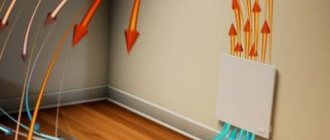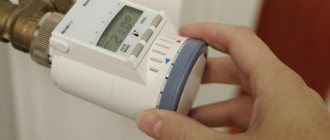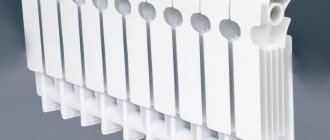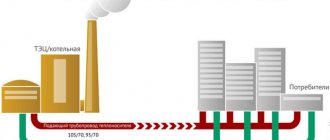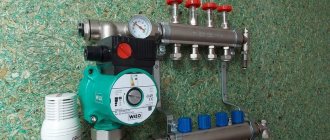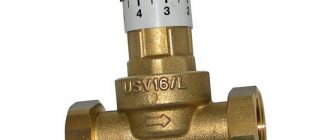For most families, utility bills are one of the largest expenses. In particular, this includes payment for heating services and home heating. So why not try to reduce these expenses? Recently, hot/cold water and gas meters have been installed in most city apartments and private houses. A specialized store will help you determine which one is best to choose. With their help, thrifty owners can significantly save resources, and therefore reduce the amount of utility bills. It's time to add another device to the ones mentioned above that can count the heat you use. We are talking about heating meters for apartments: you can learn about their types, selection and installation in an apartment from this article.
Heating meters for apartments: types, choice, installation in apartments
Operating principle of a heat meter
The task of the heating meter is to count the amount of heat that was spent on heating an individual apartment, the entire house or a private cottage. It is not just the volume of water that passed through the battery that is taken into account, but the energy that this water released into the room. The heat meter is calculated using the following formula:
Q = V *( t1— t2 )
Here V is the volume of water that passed through all the heating radiators in the apartment, t1 is the temperature in the supply line, t2 is the temperature in the discharge pipe. The result of the calculation is Q - the amount of heat transferred to the apartment. Based on this indicator, the cost of home heating services is calculated, which is included in the receipt.
You may be interested in information - Siemens water meter
To perform the above actions, the heat meter must have a relatively complex design. The device consists of the following elements.
- Flow meter is a sensor installed on the supply line of the heating system and calculates the volume of water passing through the network per unit of time.
- Thermal converters – two temperature sensors. Installed on the supply and discharge pipes of the apartment heating system. They measure the temperature difference, which is used in calculating the amount of heat spent on heating a home.
- A calculator is a device that calculates and converts the received data into the amount of heat. On modern devices it is equipped with a push-button control panel and a liquid crystal display for displaying information.
Standard set of individual (for a separate apartment) heating meter
An example of installing a heat meter for a separate apartment
Diagram showing the principle of operation of a common house heat meter
Technical characteristics of the heat meter
An apartment heat meter is designed for apartments with horizontal pipe distribution.
The operating principle is based on measuring the temperature at the exit and entrance of the system and calculating the heat used through the coolant. Accounting is due to several approaches to recording expenditure indicators with subsequent processing of the received data.
Modern models have access to a computer, and the counter values are stored in the device’s memory for up to 10 years.
The heat meter consists of:
- computer;
- 3 sensors: 2 temperature and 1 flow meter.
Calculators come with external and self-powered:
- the first type is characterized by a short length of wires and short-lived batteries (from 6 years);
- the second model requires a 24 V power supply, which requires the installation of an energy transformer.
Flow sensors are available in 3 types, and determine the heat meter model.
Electromagnetic flow meters
The devices are presented in the form of a compact hydrodynamic generator. They are characterized by the accuracy of numbers, but they react to the proximity of electrical appliances and require proper installation. The main disadvantage is the formation of salts on the electrodes, which affect the measurement accuracy.
Ultrasonic models
The work is based on the principle of oppositely installed signal emitters and receivers. The appearance is indicated by a hollow section of pipe with attached sensors, two thermometers and a heat calculator equipped with an LCD display. All you need to do is press a button to read the information.
Pros:
- the device is informative;
- does not create hydraulic pressure;
- possibility of remote reading of indicators.
Minuses:
- ultrasonic models may display incorrect readings when the water is airy (bubbles) or in a turbid environment;
- If the power supply is unstable, it requires connection via UPS.
Vane (mechanical) meters
The essence of the work is reduced to the following: a turbine is inserted into the liquid, rotating relative to the flow speed. The device is equipped with a remote signal device that reads the current flow rate.
Pros:
- reasonable price;
- power supply from internal source - batteries;
- ease of operation.
Minuses:
- sensitive to water hammer;
- the turbine, like any mechanism, wears out;
- creates pressure in the system;
- the model is not capable of storing daily information;
- impossibility of remote reading of indicators.
Installing a regulator complete with valves and a circuit board will contribute to even greater savings. If the apartment has high-quality thermal insulation and the temperature is kept within 26 °C, the regulator is able to adjust the thermal regime to a comfortable value of 22 °C, and the meter will count significantly less calories.
The presence of a device in an apartment implies control and regulated heat supply to radiators using shut-off valves. Even with one screwing of the tap (turning off everything is prohibited!) there is a noticeable difference in payment.
For example, for 35 sq. m. the owner pays up to 2000 rubles. By installing a meter, you will save at least a thousand. Savings depend on sq.m. m. room and if there is a large footage, the advantage will be obvious.
When is it possible and advisable to install a heating meter?
It should be understood that such a meter is not a panacea for high heating costs - it cannot save heat on its own. Its task is to keep accurate records of the resources spent on maintaining a comfortable temperature in your apartment during the heating season. Therefore, before making a decision to purchase a heat meter, try to calculate how much the price for heating can be reduced if it is available, and how long it will take to pay off the costs of purchasing and installing the device. Then compare the obtained figures with the average service life of the device, which is 6-8 years.
The heating meter cannot save heat on its own
Important! Do not forget about verification - the condition of the heating meter should be checked regularly by licensed specialists. In this case, you will bear the costs of this event.
In addition to the economic aspect, technical factors also influence the feasibility of installing a heat meter. First, you need to find out what kind of heating system is installed in your home. If it was built a long time ago, then, most likely, it uses a vertical heating riser - inlet and outlet pipes go from bottom to top through the entire house, with radiators located in branches from them. In this case, you will need to install several heat meters - on each separate battery. Considering the cost and service life, there may not be any savings in the end. In addition, the accuracy of heat meters installed on a separate radiator sometimes leaves much to be desired - too small a change in temperature is poorly recorded by temperature sensors.
Diagram of heating systems with vertical wiring. In this case, heating radiators in apartments are often supplied from separate risers, which significantly complicates the installation of individual metering devices
There are relatively inexpensive and simple individual heat meters installed on each individual radiator. But often the accuracy of their calculation leaves much to be desired.
Secondly, you need to know whether there is a communal heat meter and in what condition it is. If the device was installed relatively recently and works without any problems, then there is no strict need for an individual meter. It’s a different matter if there is no common building metering device - in such cases, coolant supply companies use increasing coefficients when calculating the cost of heating services, and installing a heating meter in your own apartment can significantly reduce utility costs.
Household heat meter
Thirdly, evaluate whether you are ready to monthly calculate the amount of heat and transfer it to representatives of the HOA or management company. Remember that these activities should be carried out with extreme care - an incorrectly entered figure can reduce all savings to nothing.
Fourthly, be prepared to spend money not only on drawing up a project for installing a heating meter and on the device itself, but also on installation and sealing of water meters. Of course, it is possible to install the meter yourself, but there are a number of problems here. The first is that tampering with home heating systems without special training and skills is simply dangerous. Secondly, if mistakes are made when installing the meter yourself, then the accuracy of metering the energy consumed may suffer. As a result, there will be no savings benefits. Third, difficulties may arise with the acceptance of the device - representatives of the HOA or management company may refuse to register and seal the meter installed not by licensed specialists, but by the apartment owner himself. Of course, such a refusal can be challenged, but this will require additional (and quite considerable!) expenditure of effort, time and money.
Remember, meters need to be checked every 4 years. If a malfunction is detected, the meter must be dismantled and sealed.
What types of heating meters are there?
Let's look at what types of heat meters there are. Such products are distinguished by two characteristics - the principle of operation and the installation location. The classification of heating meters according to the latest one is shown in the table below.
Table. Types of heating meters at the installation site.
Attention: The internal data of table “99” is corrupted!
According to the principle of operation, heating meters are divided into several types.
Mechanical (tachometer) heating meters
Operating principle: the main working element of such a device is a rotor or impeller, which rotates under the influence of water flow in the supply pipe of the heating system. Depending on the volume of coolant passing through it, the rotation speed of the meter rotor changes. The number of revolutions of the working element per unit time is then converted into the amount of water passing through the heating battery. Next, thermometers and a computing unit come into play.
Mechanical heating meter
Advantages: simplicity of device, lowest cost among all heat meters.
Disadvantages: during installation, a mechanical heating meter requires the installation of a filter. Also, such devices are very sensitive to the quality of water and the content of foreign impurities in them. Mechanical heat meters can become unusable if a sufficiently powerful water hammer occurs in the heating system.
Electromagnetic heating meters
Operating principle: an electromagnetic field is created at the installation site of the device in the supply pipe of the heating network. Water passing through it excites an electric current, which is recorded by the corresponding meter sensors. In addition, due to the difference in currents at the input and output of the heating system of an apartment or house, it calculates the temperature change. Then all the data enters the computing unit, which converts it into the amount of heat spent on heating the home.
Electromagnetic heating meter
Advantages: wide functionality, the ability to display a large amount of data on a liquid crystal display, high accuracy of measuring the amount of water and heat. The device is suitable for installation on a wide variety of pipe sections.
Disadvantages: high price of the device, sensitivity to iron content in water. In addition, the electromagnetic heat meter requires qualified maintenance and regular cleaning of the flow meter. Otherwise, the device begins to give false readings.
Vortex heating meters
Operating principle: an obstacle connected to the meter is placed in the supply line, and turbulence is formed in the water passing through this obstacle. Their parameters, namely the speed and number of vortices, directly depend on the coolant flow rate per unit time.
Vortex heating meter
Advantages: low sensitivity of the meter to water contamination, average cost, fairly high measurement accuracy, the ability to install the device on both horizontal and vertical sections of the supply pipe.
Disadvantages: if there are a large number of air bubbles in the heating system along with water, the device begins to give false readings and make mistakes.
Ultrasonic heating meters
Operating principle: an emitter and receiver of an ultrasonic signal sent inside the pipeline are installed in the heating system pipe. The time difference between generation and reception directly depends on the flow rate in the supply pipe of the heating system. Based on these data, the computer determines the amount of water that has passed to the batteries. Often installed as a general house heat meter.
Ultrasonic heating meter
Advantages: the highest accuracy among all other heat meters. Often such devices have functionality for regulating the flow and changing the temperature of heating radiators. Under proper conditions, ultrasonic heat meters have a long service life.
Disadvantages: such devices are very sensitive to low-quality and contaminated water - upon contact with it they quickly become unusable. They require the proper level of maintenance and the mandatory presence of a filter in front of the meter itself.
Ultrasonic counter
What types of heating meters can you buy?
Heat meters for houses with central heating differ in price and operating principle. According to the last parameter, their official classification is carried out. In private and apartment buildings the following is installed:
- Mechanical heating meters - the price ranges from 6,300 to 10,450 rubles.
The simplest and most affordable measuring devices. Due to the simplicity of the mechanism, they are durable and resistant to stress. In our company you can buy a heat meter for the following types of heating systems - vane, screw and turbine. All mechanical devices convert the translational movement of a liquid flow into rotational movements. The number of rotations is calculated by a heat calculator, which you can buy from our company at the manufacturer’s price.
Mechanical devices are assembled from several functional units - a mechanical rotor, a water meter (usually a vane type) and a heat calculator. We recommend purchasing a mechanical class thermal energy meter for installation in individual apartments and small private or multi-apartment buildings. Their main disadvantage is sensitivity to the quality of the coolant.
If the heating system uses a hard coolant with a large volume of impurities (scale, iron, scale, etc.), then over time mechanical heat meters for heating, even at a high price, will begin to record readings with a large error.
Manufacturers offering reliable and affordable mechanical meters for heating in apartments and houses are Kombik, Pulsar and ELF. The most durable and most frequently purchased models are TSK-5, 7 and 9, T-34.
- Electromagnetic heat energy meters - price from 9,700 to 15,400 rubles.
The main unit of measuring instruments is an electromagnetic flow meter. It is designed to record the quantitative parameters of the coolant, its volume entering the system and the temperature at the inlet/outlet of the system. Most experts recommend buying a heat meter of the electromagnetic type, since it is very reliable. Measuring equipment of this class is unpretentious to the heat carrier, adapted to difficult operating conditions and consists of a minimum set of functional units. The latter feature guarantees the stability of the heat meter for heating, the price of which will depend on the additional capabilities of the equipment.
But while there are a huge number of advantages, electromagnetic devices also have disadvantages. They require very high-quality and competent installation, and also require regular and professional maintenance. From the company you can order heating meters for your apartment at a reasonable price, with installation and subsequent maintenance. Experts will advise on the operation of devices and give recommendations.
Among the reliable manufacturers offering affordable electromagnetic heat meters are TMK, Emis-Mag, Pramer, VIS.T and some others. The most popular device models on the market are Pramer-510, 517, 550 and 525X, as well as TS.TMK-N and Dio-99TSP.
- Ultrasonic heat meters for heating - price from 18,000 to 37,000 rubles.
For heating systems where the coolant is of high quality, we recommend purchasing an ultrasonic heat meter. Modern equipment performs the most accurate measurements. Their operating principle is based on calculating the time period during which an ultrasonic wave passes through the coolant. Another advantage of measuring instruments is the quick calculation of indicators. Changes in temperature, volume of substance in the system and pressure are recorded by the device instantly. Even an inexpensive heat meter for an apartment or house will last its entire operational life without the need for repairs.
The best price for a heat meter is offered by the following manufacturers - QUNDIS, Pulsar, Smalt, Sanext and Pulse. Customers often chose the following ultrasonic models UltraHeaT-UH50 and 2WR6.
- Vortex heat meters for apartments and houses - price from 7,000 to 13,400 rubles.
The main advantage of measuring instruments is that it is possible to install low-cost heat meters in an apartment or house on both the vertical and horizontal sections of the heating system. The operating principle of the equipment is based on the creation of a vortex flow that occurs behind an installed obstacle. The computing node of the device analyzes it and, based on the data received, makes a calculation of the amount of energy expended. We recommend purchasing vortex heat meters for heating for an apartment or house due to the simple installation of the equipment.
Models of this class are equipped with a large number of functional units - a measuring electrode, a prism and a magnet. Due to additional elements, the device has higher calculation accuracy. It is possible to install heat meters of this type on heating systems whose coolant is not of high quality. The equipment almost does not react to impurities in the coolant or deposits on pipes. If the house was built a long time ago, then installing measuring equipment is associated with a number of difficulties. If you decide to order a heating meter with a vortex-type installation at a reasonable price, then its installation can be carried out on any part of the network. The fact is that vortex devices are not demanding on the length parameters of straight sections.
The best cost of a heat meter for an apartment and a house is offered by the following brands - Etalon RM, Dnepr, Emis-Vikhr, TSK, Karat and some other manufacturers. Popular models include equipment Karat 520 and RS, Emis-Vikhr 200 and 205. The heating meter in an apartment has proven itself well, the price of which will be slightly higher than that of other devices of this type - 14,950 rubles, KST-22.
Not so long ago, heat meters appeared on the market, the installation of which is carried out directly on the radiator. What are they good for? In most apartment buildings, the heating system is of a vertical type. This means that the apartment owner will have to buy heat meters for the apartment for each riser - the price will increase significantly (the cost of all devices plus the cost of their installation). Therefore, installing individual metering devices in 78% of cases is not cost-effective. The solution in this case is provided by radiator heat metering devices, the price of which ranges from 1,100 to 2,780 rubles and more. The devices are also mounted on each radiator battery in the apartment and are complemented by a thermostat.
Features of choosing a heating meter
So, you are familiar with the types of heat meters. Now you need to understand how not to make a mistake when choosing a device and buy something that will work for as long as possible without any problems. There are several simple recommendations regarding the purchase of heat meters.
- Assess whether there is enough space on the heating supply line of your apartment where water meters can be installed. If there is not too much space, give preference to the electromagnetic option, as it is the most compact and not demanding on the installation location.
- It is also advisable to choose an electromagnetic heating meter for those heating systems where there is increased pressure in the pipes - more than 0.7 kg/cm2. Under such conditions, the service life of other devices will be significantly lower.
- If your home's heating system is supplied with sufficiently clean water, the temperature and pressure of which are within normal limits, choose a mechanical heat meter.
- Give preference to those devices in which the computing unit has the ability to be independently powered by a battery - in this case, the meter will work even if there is a power outage.
Types of heat metering devices
Important! Choose only those devices for which the manufacturer and seller provide a fairly long warranty - 3-4 years or more. Purchasing meters with a shorter warranty period is risky - most likely, their quality and durability leave much to be desired.
Prices for heating meters
heating meters for apartments
Benefits of a home meter
If you are ready to decide to install a personal heat meter in your apartment, remember that by itself it will not provide an economic effect, but it will allow you to save on heating within reason, reflecting current consumption. You will notice that the slightest fluctuation in temperature downward will affect the contents of the wallet in an increasing direction.
The meter allows you
to control consumption if the unit is installed correctly and the thermostat controls the temperature. By lowering the temperature before leaving for work, at the end of the month your rationality will turn into an economic bonus. Only reducing the parameters in 1C to 6% saves thermal energy.
If you are thinking about installing a device in an apartment, you should know that the procedure is unreasonably complicated, you will need to collect the required list of documents, and prepare for unforeseen expenses.
Installing a heating meter in an apartment
The main difficulties in the process of installing a heat metering device in an apartment are related not so much to technical issues, but to bureaucratic ones. To install the meter, you need to complete a large number of documents. You will get a more accurate idea of this event and the actions that need to be taken from the step-by-step instructions given in this section of the article.
Installing a heating meter in the apartment seems like a reasonable solution
Step 1. Contact the management company or any other organization that provides utility services, including heat.
You must take the following documents with you:
- application for the purchase and installation of a heat meter;
- technical passport of the apartment;
- documents confirming ownership of the apartment;
If you are not the only owner of the property, then to the list presented above you need to add the written consent of the other owners of the apartment.
Step 2. Obtain from the management company the technical specifications (hereinafter referred to as TS) for the installation of a thermal energy meter. It should indicate all the requirements for the heating meter that will be installed in your apartment in the future. Read the technical conditions carefully and make copies of the document if necessary.
Example of specifications for installing a heating meter
Important! In some cases, the management company may refuse to install a heat meter in an apartment. This may be due to both technical reasons and the dishonesty of representatives of the management company. In any case, you have the right to request a document that provides a clear and precise justification for the refusal of permission to install a meter.
Step 3. With the technical specifications and other documents specified above, go to the design organization. Together, choose a heating meter model that is suitable both in terms of cost and installation and operating conditions.
Step 4. Have the organization draw up the project. Due to the complexity and specificity of the activity, it is not possible to create it yourself.
The project for installing a heat meter in an apartment should include:
- plan of the apartment's utility networks with the installation location of the device;
- calculation of heat and pressure load on the meter;
- calculations of possible changes in pressure in the heating system after installation of the device;
- methodology for determining payment for heating based on meter readings and tariffs;
- calculation of the amount of heat spent on heating a home and not taken into account by the device.
An example of a diagram according to which a heating meter will be installed in the future
Heating meter installation diagram
Important! Before concluding an agreement with a design organization, be sure to collect all available information about it - how long and successfully it has been working, whether any of your friends have used their services, how professional the specialists are and whether they have the necessary licenses and permits for such activities.
Step 5. With the finished project and one of the representatives of the organization that developed it, return to the management company. There it is necessary to agree on all documents and obtain final permission for installation work. Some design organizations take on this stage of installing a heating meter, but for an additional fee.
Step 6. Purchase a heat meter.
Ultrasonic heat meter Itron CF-UltraMaXX
Step 7. Contact an organization that installs such equipment. As was already said in one of the sections of the article earlier, independent installation of a heat meter is possible, but undesirable - there is a risk that the device will subsequently not be accepted by a representative of the management company and, most likely, everything will have to be redone.
Step 8. Select the day and time when the meter will be installed in the apartment. It is advisable that at approximately the same time or a little later, representatives of the management company and the design organization visit you to accept and seal the thermal energy metering unit.
Step 9. Together with licensed and professional specialists, install the meter. The process goes something like this.
- The supply to the heating system is shut off.
- Water is draining from the pipes.
- At the selected location, the supply and discharge pipes are cut.
- The pipes are being cleaned.
- Appropriate shut-off and fastening valves are installed in the cut-out areas.
- Craftsmen install a water flow sensor.
- Then the computer block is mounted on it or nearby.
- Temperature sensors are connected to the inlet and outlet pipes.
- The correct installation is checked and, if necessary, troubleshooting is carried out.
- Test run of water.
Some of these stages are captured in the photographs below.
Preparing the mounting hardware for the heating outlet pipe
Installation of shut-off valves on the outlet pipe and the location where one of the temperature sensors will be located
Preparing the heating supply pipe for installing a meter
Installation of a sensor for the volume of liquid passing through the heating supply pipe
Attaching the water volume sensor. The spiral black wire on the right belongs to the thermal converter
Connecting a second thermal converter
Installation of the heat meter computing unit
Sealing heating meter elements
Step 10. Together with the foreman who installed the meter, and representatives of the management company and design organization, draw up an acceptance certificate for the thermal energy meter. An example document is presented below. Then the meter is sealed. The device is now completely ready for use.
An example of an acceptance certificate for a thermal energy meter
Important! In addition to installing a heating meter, if possible, try to carry out a set of measures to insulate your home and close all kinds of “cold bridges” - the less energy required to heat the apartment, the smaller the numbers on the device will be. And, as a result, the price for heating services in the receipt will also be lower.


